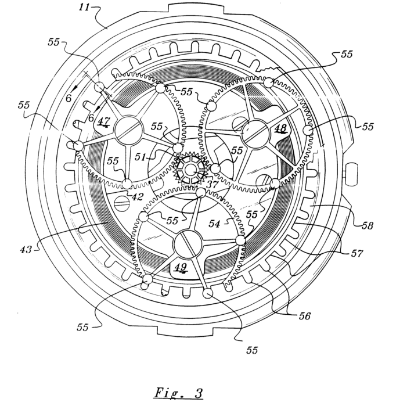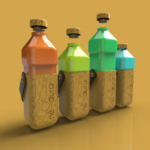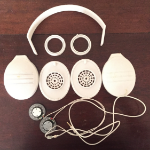Want to know about the costs associated with developing your new product idea?
It is safe to say that everyone from every educational background and profession has a good idea for a new product design at least once in a lifetime. When people use everyday products, such as home appliances, laptops, shoes, cars, smartphones, pencils, or furniture pieces, they always complain about something and come up with an idea supposedly to make those things better. Sometimes the ideas are brilliant, but more often than not, the ideas are simply preposterous. Unfortunately, when the ideas are indeed good, fresh, unique, and, technically feasible, most people don’t know how to transform those concepts to reality and introduce the inventions to the market. Although the process is neither very easy nor cost-free, a truly creative invention design is worth the trouble and financial investment. There are multiple steps to go through from the moment you conceive of the idea until you transform it into a fully-working product to generate revenue from sales.
1. Designing & Brainstorming
 This point in the process where you brainstorm multiple ideas to refine the concept you have in mind. Unless you hire a group of people to research and development work, the design process usually costs nothing. Beyond compiling a collection of multiple ideas on the product itself, such as colors, textures, materials, shapes, features, and functions, one of the most challenging parts of the process is market research. Before you proceed with the product concept, you need to be sure that your ideas are indeed new and preferably unique, meaning that you will fill an empty market segment which translates into a higher chance of commercial success. If there are already similar products available, make some design variations to avoid legal issues regarding patent rights. Having some friends and colleagues to help you should get things done much quicker.
This point in the process where you brainstorm multiple ideas to refine the concept you have in mind. Unless you hire a group of people to research and development work, the design process usually costs nothing. Beyond compiling a collection of multiple ideas on the product itself, such as colors, textures, materials, shapes, features, and functions, one of the most challenging parts of the process is market research. Before you proceed with the product concept, you need to be sure that your ideas are indeed new and preferably unique, meaning that you will fill an empty market segment which translates into a higher chance of commercial success. If there are already similar products available, make some design variations to avoid legal issues regarding patent rights. Having some friends and colleagues to help you should get things done much quicker.
Make notes of all the ideas you have and draw some simple sketches in an inventors’ notebook. Keep the notes and drawings organized and annotated to provide details. The notebook is of the utmost importance when you want to file your patent for the invention at a later date.
2. Patent filing
To protect your intellectual property, you can file a provisional patent. It is valid for 12-months so there should be enough time for you to develop the ideas further without having to worry about someone else stealing or copying your product concept. Filing a patent is not free, even if you do it without assistance from a professional registered patent attorney. The cost depends on the size of your business and type of product, but provisional patents typically cost no more than $280, and it is valid for a year; if you operate micro or small business entity, the fee is much less than that.

Once granted, you have the valid legal protection of your intellectual property for one year. Use the time you have to rapidly develop the ideas and build either a digital prototype or fully-working physical model (both if possible). You don’t need a prototype to file for a patent, as long as you can prove the ideas are truly yours and distinguishable from all existing products in the market. For those purposes, your notes and sketches are indispensable documents. Having a prototype improves your chances of acquiring a patent, but it is not mandatory. When the provisional patent is no longer active, file for a non-provisional (utility) patent. Although it costs more money, this expense is necessary to prevent others from copying your products without legal permission.
It is recommended that you hire a registered patent attorney to apply. An attorney can provide legal counsel and to draft the application with great technical details so that you can avoid any potential legal issues at a later time. If the services of a patent attorney are involved, the cost for filing the patent increases to at least $2,000 for a provisional patent. Applying for utility patent can cost up to more than $16,000 for a complex product; patents for simpler products are usually more affordable. Contact multiple attorneys and see if you can ask for a lower estimate. Hire only an attorney registered with the patent office in your country. If you are in the U.S., look for a legal practitioner on the USPTO website.
3. Prototyping
Most (if not all) manufacturers will want you to have a fully-working prototype design before they agree to continue on to mass-produce the product. Have a physical prototype if possible, although a digital one is often sufficient to explain what the product should look and feel like, and how it should perform. Work with professional 3D CAD modeler to create digital hyper-realistic interactive imagery of the product. Bring this digital prototype for presentation purposes and showcase your product’s potential to inventors and manufacturers. If a physical prototype is necessary, have a custom manufacturer build the product based on the digital imagery.

The cost for hiring 3D CAD modeler varies depending on the quality of the service and complexity of the design. Be prepared to spend at least $2,000 to get reasonable quality and good completion time. Building a physical prototype also costs money, because you want a fully-working model, not t simply a representation of what the product would look like. The cost varies, as well, depending on the materials used, the size and difficulty level. As an example, there is a big difference in sophistication (and therefore cost) between creating a cast-iron figure and a robot; you have to pay more for the latter.
4. Reaching the Market
Assuming all the other points in the process have gone as well as intended, and you have found manufacturers to mass-produce your invention, there are still some more expenses to consider until the products reach the market. It takes a lot of meticulous calculations to come up with a reasonable manufacturing cost. The main reason is that you don’t have a factory with big machines capable of mass-production. You have to collaborate with a manufacturing partner who also needs to make a reasonable profit. The cost for bringing your invention to market is also associated with the following factors:
- Materials: The price of raw materials plays a huge factor. To get a rough estimate, take a look at the invoices for the prototyping process. Manufacturing in low volume costs more money because you often get cheaper materials if you buy in bulk for large-scale production. Determine the raw materials you need (plastic, paper, metals, fabric, leather, electrical components, etc.) and research their prices from large suppliers.
- Manufacturing Quantity: Factory partners often require a minimum order quantity (MOQ) within reasonable profit margin in relation to production costs including materials and labor. Let’s say the minimum order is 5,000 pieces; calculate the volume of materials necessary for the production process. The number you get now only covers the cost of materials.
- Tools: Because your products are unique, the factory may need to build custom machines. While the factory appears to cover the expense to get the specialized tools, the cost is passed along to you as the owner/designer of the product. As a result, you must pass along the exact cost to potential consumers, which means they pay more for the product.
- Quality: As always, higher quality means higher cost. A factory that implements better manufacturing and safety standards will ask you for a higher cost.
- Packaging: Consumers are interested in products wrapped in better-looking packaging. Not only does the package protect the product inside, but it also acts as a marketing tool.
 All those parts of the process cost considerably on your part. Once again, there is no standard pricing. You can either build a joint venture with a small factory to share the production cost or outsource the manufacturing process to retain sole ownership of the product. If you decide to outsource, the factory is working for you; the products are made for you, not for the end consumers. A joint venture eases the financial burden to get a product to market, but, quite often, it does not happen, unless the product is overwhelmingly innovative and profitable. Many businesses outsource the manufacturing process overseas to save money, especially in countries where the labor cost is much lower than in the home country. For example, a lot of American businesses collaborate with factories in China to minimize the labor cost. It is legal and not usually problematic as long as you can enforce proper quality control and establish good communication.
All those parts of the process cost considerably on your part. Once again, there is no standard pricing. You can either build a joint venture with a small factory to share the production cost or outsource the manufacturing process to retain sole ownership of the product. If you decide to outsource, the factory is working for you; the products are made for you, not for the end consumers. A joint venture eases the financial burden to get a product to market, but, quite often, it does not happen, unless the product is overwhelmingly innovative and profitable. Many businesses outsource the manufacturing process overseas to save money, especially in countries where the labor cost is much lower than in the home country. For example, a lot of American businesses collaborate with factories in China to minimize the labor cost. It is legal and not usually problematic as long as you can enforce proper quality control and establish good communication.
 To attract consumers/retailers, there is another process which may or may not cost a lot of money: marketing. Just because you have managed to bring your inventions to market, does not mean consumers will like to purchase it. One of the most common methods of marketing in today’s market is online advertising. You can save money by setting up a simple website or use social media as a marketing platform. Print publications and television ads are also possible. Keep in mind that the products must be distributed from the factory warehouse to sellers or retailers. Nobody is going to purchase your product if it stays in the manufacturing facility. You may also need to rent storage facilities so that retailers have easier and quicker access to the product. You might also sell the products directly to consumers, at least for the first while until you have enough ROI and the products earn popularity. As the order increases, production capacity must be able to keep up with the demand. With larger volume production, you may be able to sell at a lower price to retailers as well.
To attract consumers/retailers, there is another process which may or may not cost a lot of money: marketing. Just because you have managed to bring your inventions to market, does not mean consumers will like to purchase it. One of the most common methods of marketing in today’s market is online advertising. You can save money by setting up a simple website or use social media as a marketing platform. Print publications and television ads are also possible. Keep in mind that the products must be distributed from the factory warehouse to sellers or retailers. Nobody is going to purchase your product if it stays in the manufacturing facility. You may also need to rent storage facilities so that retailers have easier and quicker access to the product. You might also sell the products directly to consumers, at least for the first while until you have enough ROI and the products earn popularity. As the order increases, production capacity must be able to keep up with the demand. With larger volume production, you may be able to sell at a lower price to retailers as well.
Want a free quote on product design project?
Learn more about how we help clients hire vetted CAD designers and 3D modelers on demand. Just use our free quote form and we’ll get back to you with a free estimate on your new product idea in under 24-hours.
